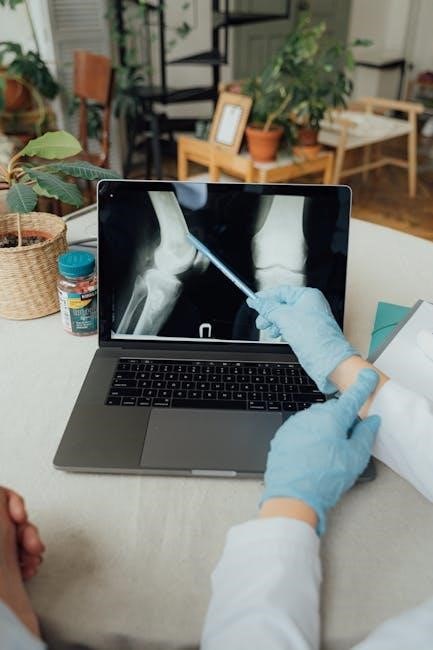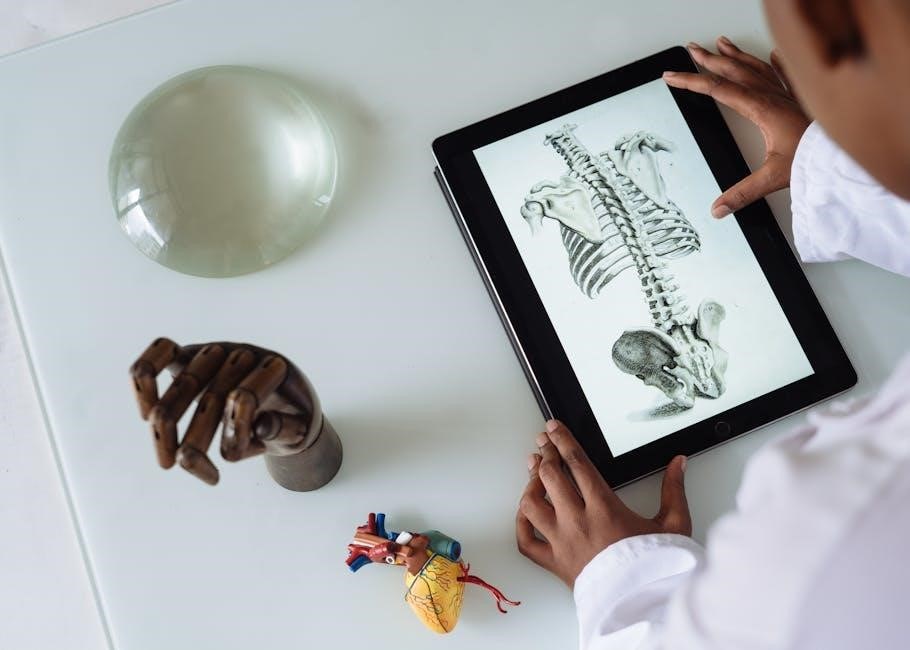Guided Bone and Tissue Regeneration are advanced surgical procedures utilizing barrier membranes to regenerate bone and tissue, preventing soft tissue invasion. Ideal for periodontal defects and implant preparation.
Overview of Guided Bone Regeneration (GBR)
Guided Bone Regeneration (GBR) is a surgical technique that promotes bone growth in deficient areas by using barrier membranes to prevent soft tissue invasion. This method creates a stable environment for osteogenesis, enabling natural bone healing. GBR is widely applied in dental and maxillofacial surgery to address alveolar ridge deficiencies, periodontal defects, and peri-implant bone loss. The procedure involves placing osteoplastic materials, such as autografts, allografts, or synthetic substitutes, beneath a membrane to facilitate bone regeneration. Advanced materials like bioactive glass and nanocomposites enhance osteoconductivity and bioactivity, making GBR a reliable and innovative approach for restoring bone structure and ensuring successful implant integration.
Overview of Guided Tissue Regeneration (GTR)
Guided Tissue Regeneration (GTR) is a surgical procedure that enhances the growth of specific tissues, such as periodontal ligament and bone, by using barrier membranes. These membranes prevent the invasion of epithelial and connective tissue into the defect, allowing preferred cells to regenerate. GTR is primarily used to treat periodontal defects, promoting the reformation of lost periodontal structures. The technique is particularly effective in deep periodontal pockets and furcation defects. Membranes can be non-resorbable or resorbable, with the latter offering advantages like reduced surgical interventions. GTR not only restores functional tissue but also creates a stable environment for dental implants, improving long-term oral health outcomes.
Key Concepts and Mechanisms
Guided regeneration relies on barrier membranes, osteoconduction, and osteoinduction, creating space for tissue growth while preventing soft-tissue interference, ensuring targeted bone and periodontal regeneration.
Barrier Membranes in GBR and GTR
Barrier membranes are critical in guided bone and tissue regeneration, preventing soft-tissue invasion into defects. They create a protected space for bone or periodontal tissue to grow. Non-resorbable membranes, like PTFE, require removal, while resorbable options, such as collagen or synthetic polymers, degrade over time. These membranes guide healing by maintaining defect integrity and promoting osteoconduction or periodontal regeneration. Their design and material influence tissue response, with bioactive coatings enhancing bone formation. Proper membrane selection and placement are essential for clinical success, ensuring optimal regeneration outcomes in both bone and periodontal applications.
Role of Osteoplastic Materials
Osteoplastic materials play a pivotal role in guided bone regeneration by providing a scaffold for osteoconduction and osteoinduction. These materials, such as bioactive glass, hydroxyapatite, and synthetic composites, promote bone cell attachment and differentiation. Their bioactive properties enhance healing by stimulating cellular responses, ensuring proper bone formation. Osteoplastic materials are often combined with barrier membranes to maintain space and stability during regeneration. They are particularly effective in treating periodontal defects and peri-implant bone deficiencies, offering a biocompatible and durable framework for tissue repair. The selection of these materials depends on their degradation rate and ability to mimic natural bone structure, making them indispensable in modern regenerative therapies.
Importance of Space Maintenance in Regeneration
Space maintenance is crucial in guided bone and tissue regeneration as it ensures the proper formation of new bone and tissue. Without sufficient space, bone cells cannot proliferate effectively, leading to incomplete regeneration. Barrier membranes play a key role in maintaining this space by preventing soft-tissue invasion into the defect. The stability of the maintained space directly influences the success of the procedure, as it allows bone cells to differentiate and form new tissue. This principle is particularly vital in procedures like alveolar ridge augmentation and periodontal bone defect treatment, where precise control over the regenerative environment is essential for achieving desired outcomes.

Types of Membranes Used in GBR and GTR
Membranes used in GBR and GTR include non-resorbable and resorbable options, such as Gore-Tex and collagen, designed to prevent soft tissue invasion and promote bone regeneration.
Non-Resorbable Membranes
Non-resorbable membranes, such as Gore-Tex (polytetrafluoroethylene), are durable and require a second surgery for removal. They provide excellent space maintenance and tissue separation, ensuring optimal bone regeneration.
Resorbable Membranes
Resorbable membranes are made from materials like collagen or synthetic polymers (e.g., PLA, PLGA) and naturally degrade over time, eliminating the need for removal surgery. They prevent soft tissue invasion, promote bone and tissue regeneration, and minimize patient discomfort. Their biocompatibility and gradual degradation align with the healing process, making them a popular choice in GBR and GTR. However, their mechanical stability and degradation rates must be carefully controlled to ensure optimal regeneration outcomes. Resorbable membranes offer a convenient alternative to non-resorbable options, reducing the need for additional procedures while maintaining efficacy in tissue repair and bone growth.
Comparison of Membrane Types
Resorbable and non-resorbable membranes differ in material, function, and clinical application. Non-resorbable membranes, like PTFE, are durable and provide long-term stability but require a second surgery for removal. Resorbable membranes, made from materials such as collagen or biodegradable polymers, eliminate the need for removal and adapt to the healing process. Non-resorbable options are often chosen for larger defects, while resorbable membranes are preferred for smaller defects and reduced patient morbidity. The choice depends on the defect’s size, healing requirements, and patient-specific factors. Both types are effective but offer distinct advantages in terms of biocompatibility, cost, and clinical convenience.
Bone Substitutes and Biomaterials
Bone substitutes and biomaterials, such as autogenous grafts, allografts, and synthetic materials, play a critical role in tissue regeneration, offering structural support and promoting bone repair naturally.
Autogenous Bone Grafts
Autogenous bone grafts, harvested from the patient’s own body, are considered the gold standard for bone regeneration due to their osteoconductive, osteogenic, and osteoinductive properties. Harvested from sites like the ilium, mandible, or tibia, these grafts ensure high biocompatibility and minimal risk of immunogenic reactions. They provide live cells that actively contribute to bone repair, making them ideal for complex defects. However, their use is limited by availability and the need for additional surgery to harvest the graft, which may increase patient morbidity. Despite these challenges, autogenous bone grafts remain a cornerstone in guided bone and tissue regeneration procedures, particularly in dental and maxillofacial surgery.
Allografts and Xenografts
Allografts, derived from human donors, and xenografts, sourced from animals, are widely used in bone regeneration. Allografts are processed to remove antigens, minimizing immune responses, while xenografts are treated to enhance biocompatibility. Both serve as osteoconductive scaffolds, promoting bone growth without active cellular contribution. Allografts may also exhibit osteoinductive properties, stimulating bone formation. Xenografts, such as bovine-derived materials, offer porosity that mimics natural bone structure. These grafts eliminate the need for a second surgical site, reducing patient morbidity. However, they lack living cells, which can slow regeneration compared to autografts. Despite this, allografts and xenografts remain valuable options in guided bone regeneration due to their availability and compatibility.
Synthetic Bone Substitutes
Synthetic bone substitutes, such as bioactive glass, ceramic composites, and calcium phosphate-based materials, are engineered to mimic natural bone structure and function. These materials are biocompatible, osteoconductive, and often bioactive, promoting cell attachment and vascularization. Bioactive glass, for instance, stimulates bone regeneration through ion exchange, releasing calcium and silicate ions that enhance osteogenesis. Synthetic substitutes are advantageous as they eliminate the need for donor materials, reducing immune responses and disease transmission risks. They also offer consistent quality and availability. Advanced formulations incorporate porosity and resorbability, allowing gradual replacement by natural bone tissue. These materials are widely used in guided bone regeneration, particularly in alveolar ridge augmentation and peri-implant bone deficiencies.

Applications in Dental and Maxillofacial Surgery
Guided bone and tissue regeneration is widely applied in treating periodontal defects, addressing peri-implant bone loss, and enhancing alveolar ridges for dental implants.
Periodontal Bone Defects
Periodontal bone defects arise from gum disease, leading to loss of supporting bone around teeth; Guided tissue regeneration uses barrier membranes to regenerate this lost bone and tissue, preventing further progression of periodontal disease. These defects can vary in severity, from shallow craters to deep angular defects. By blocking soft tissue ingrowth, the membrane creates a space for bone and periodontal ligament to reform. This technique is highly effective in restoring the natural architecture of the periodontal structures, thereby stabilizing teeth and improving long-term oral health outcomes. Successful regeneration often depends on proper membrane selection and surgical technique.
Peri-Implant Bone Deficiencies
Peri-implant bone deficiencies occur when the jawbone around dental implants deteriorates, compromising implant stability and function. Guided bone regeneration (GBR) is a proven solution to address these defects. By using barrier membranes and osteoplastic materials, GBR prevents soft tissue encroachment, allowing bone to regrow around the implant. This technique is particularly effective in cases of insufficient bone volume due to bone resorption or implant placement in deficient sites. Successful regeneration enhances implant osseointegration, ensuring long-term stability and aesthetic outcomes. GBR is often combined with bone substitutes to optimize results, making it a critical approach in modern implantology for addressing peri-implant bone loss.
Alveolar Ridge Augmentation
Alveolar ridge augmentation is a procedure to restore lost bone in the jaw, particularly in cases of severe resorption. Guided bone regeneration (GBR) plays a key role in this process, utilizing barrier membranes to contain bone grafts and promote new bone formation. This technique is essential for patients with insufficient ridge width or height, often due to tooth loss or trauma. By maintaining space for osteogenesis, GBR enables the growth of dense, functional bone, facilitating successful dental implant placement. Combined with bone substitutes like autografts or bioactive materials, alveolar ridge augmentation restores facial aesthetics and chewing function, offering a durable solution for complex bone deficiencies.

Surgical Techniques and Procedures
Guided bone and tissue regeneration employs advanced surgical methods, including membrane placement and bone grafting, to facilitate controlled tissue growth and bone formation in deficient areas.
Guided Bone Regeneration Techniques
Guided bone regeneration involves the use of barrier membranes and osteoconductive materials to direct bone growth in deficient areas. Techniques include membrane placement, bone grafting, and stabilization. Barrier membranes prevent soft tissue invasion, creating a protected space for bone healing. Autogenous bone grafts, allografts, and synthetic materials are commonly used to enhance regeneration. These methods are applied in treating periodontal defects, alveolar ridge augmentation, and peri-implant bone deficiencies. Advanced techniques incorporate bioactive glass and nanotechnology to improve osteoconduction and bioactivity. Clinical outcomes demonstrate significant bone formation, enabling successful dental implant placement and restoring functional anatomy. Ongoing research focuses on optimizing materials and procedures for predictable results.
Guided Tissue Regeneration Techniques
Guided Tissue Regeneration (GTR) employs barrier membranes to regenerate lost periodontal tissue and support bone. Techniques involve placing membranes over defects to prevent soft tissue infiltration, allowing periodontal ligament and bone cells to repopulate. Non-resorbable membranes, like PTFE, or resorbable materials, such as collagen, are used. GTR is effective in treating periodontal pockets, furcation defects, and enhancing implant site preparation. Combined with bone grafts or biactive materials, it promotes tissue repair. Clinical applications focus on restoring periodontal health and stabilizing teeth. Membrane exposure risks exist, but advancements in materials improve predictability and patient outcomes, making GTR a cornerstone in periodontal and implant surgery.
Combined Approaches for Complex Defects
Combined approaches for complex defects integrate guided bone and tissue regeneration techniques to address large-scale deficiencies. These strategies often involve the simultaneous use of barrier membranes, bone substitutes, and growth factors to enhance healing. For instance, GBR and GTR can be combined to regenerate both bone and periodontal tissue in segmental defects. Advanced materials like nanocomposites and bioactive glass are increasingly used to improve outcomes. Such hybrid methods are particularly effective in treating critical-size defects, ensuring proper space maintenance and tissue ingrowth. These combined approaches minimize complications and optimize regeneration, offering a comprehensive solution for complex maxillofacial and periodontal challenges.
Recent Innovations and Advances
Recent advancements include nanotechnology, bioactive glass, and 3D-printed scaffolds, enhancing bone and tissue regeneration. These innovations improve material bioactivity, osteoconductivity, and personalized treatment options for complex defects.
Nanotechnology in Bone Regeneration
Nanotechnology has revolutionized bone regeneration by creating nanostructured materials that mimic bone’s natural structure. These materials enhance cellular adhesion, proliferation, and differentiation, promoting faster healing. Nanoparticles can deliver growth factors directly to defect sites, stimulating osteogenesis. Additionally, nanocomposites combining bioceramics and polymers offer improved bioactivity and mechanical strength. Researchers are exploring nano-scaffolds that degrade gradually, maintaining structural support while new tissue forms. These advancements not only improve regeneration efficiency but also enable personalized treatments tailored to specific patient needs, marking a significant leap forward in guided bone and tissue regeneration techniques.
Bioactive Glass and Ceramic Composites
Bioactive glass and ceramic composites are emerging as powerful tools in guided bone regeneration due to their ability to promote cellular activity and tissue integration. These materials release bioactive ions, such as calcium and silicon, which stimulate osteoblast proliferation and enhance bone formation. Their high bioactivity and osteoconductivity make them ideal for repairing bone defects and fostering tissue regeneration. When combined with biodegradable polymers, these composites form nanocomposites that mimic the natural structure of bone, providing both structural support and biological cues for healing. Such advancements are paving the way for more effective and sustainable solutions in bone and tissue regeneration therapies.
3D-Printed Scaffolds for Tissue Engineering
3D-printed scaffolds are revolutionizing tissue engineering by offering customized, porous structures that mimic natural bone architecture. These scaffolds, made from bioceramics, biodegradable polymers, or composite materials, provide a framework for cell attachment, proliferation, and differentiation. Their high porosity enhances nutrient delivery and waste removal, promoting bone regeneration. By integrating bioactive materials and growth factors, 3D-printed scaffolds can stimulate osteogenesis and vascularization. This technology enables precise fitting to defective bone sites, improving surgical outcomes. Additionally, their biodegradability ensures they gradually resorb as new tissue forms, minimizing long-term complications. These advancements hold great promise for treating complex bone defects and enhancing guided bone regeneration therapies.
Challenges and Limitations
Challenges include membrane exposure, inconsistent biodegradation rates, and high costs of advanced materials, limiting accessibility for some patients and impacting clinical outcomes in bone regeneration.
Membrane Exposure and Complications
Membrane exposure is a common complication in guided bone and tissue regeneration, often leading to infection and graft failure. Non-resorbable membranes are more prone to exposure compared to resorbable ones. Early detection and management are critical to prevent bacterial infiltration and ensure proper healing. Membrane exposure can significantly hinder the regeneration process, requiring additional surgical interventions. Factors such as surgical technique, material properties, and patient-specific healing capacities influence the risk of complications. Proper implantation and post-operative care are essential to minimize these challenges and achieve successful bone and tissue regeneration outcomes.
Material Biodegradation and Longevity
Material biodegradation and longevity play a critical role in guided bone and tissue regeneration. Resorbable membranes, such as collagen or synthetic polymers, degrade naturally over time, eliminating the need for removal. However, their degradation rate must align with tissue regeneration to avoid premature loss of structural support. Non-resorbable membranes, like PTFE, remain intact longer but may require surgical removal, posing risks of exposure or infection. The balance between material longevity and biodegradation is essential for optimal outcomes, as improper degradation can hinder healing or lead to inflammatory responses. Advances in biomaterials aim to enhance durability while ensuring compatibility with the body’s natural repair processes.
Cost and Accessibility of Advanced Materials
The cost and accessibility of advanced materials in guided bone and tissue regeneration pose significant challenges. High-performance biomaterials, such as bioactive glass and nanocomposites, are often expensive due to complex manufacturing processes and research investments. Additionally, the limited availability of cutting-edge materials in developing regions restricts their widespread use. These factors hinder equitable access to innovative treatments, making them less attainable for patients in resource-limited settings. Efforts to reduce production costs and improve distribution networks are essential to enhance global accessibility and ensure that advanced materials benefit a broader population. Addressing these economic barriers is crucial for advancing regenerative therapies worldwide.

Future Perspectives and Research Directions
Future advancements in guided bone and tissue regeneration emphasize stem cell therapy, gene-activated materials, and personalized medicine to enhance healing and regenerate complex tissues effectively.
Stem Cell Therapy in Tissue Regeneration
Stem cell therapy offers promising potential in tissue regeneration by utilizing stem cells’ ability to differentiate into specific cell types. These cells can be sourced from various tissues, including bone marrow and adipose tissue, and are particularly effective in regenerating damaged bone and periodontal tissues. Stem cells promote healing by secreting growth factors that enhance osteogenesis and angiogenesis, critical for bone formation. Researchers are exploring the integration of stem cells with biomaterials and scaffolds to create tissue-engineered constructs. This approach aims to improve the predictability and efficiency of guided bone and tissue regeneration, particularly in complex defects. Ongoing studies focus on optimizing cell viability and ensuring long-term stability of regenerated tissues.
Gene-Activated Osteoplastic Materials
Gene-activated osteoplastic materials represent a cutting-edge approach in bone regeneration, combining biomaterials with genetic elements to enhance healing. These materials deliver specific genes to cells, promoting the production of growth factors like BMP-2 or VEGF, which stimulate bone formation and vascularization. Unlike traditional methods, gene-activated materials induce local cells to produce osteoinductive factors, reducing reliance on external grafts. This technology is particularly promising for complex defects, as it ensures sustained release of therapeutic genes. Research highlights their potential to integrate with scaffolds for tissue engineering, offering a tailored solution for bone regeneration. This innovative approach aims to improve the efficiency and predictability of guided bone regeneration procedures.
Personalized Medicine in Bone Regeneration
Personalized medicine in bone regeneration tailors treatments to individual patient needs, enhancing outcomes. Advances in 3D printing and biomaterials enable customized scaffolds and implants, matching patient anatomy; Genetic profiling identifies optimal growth factors, optimizing healing. Biocompatible materials are selected based on patient conditions, improving integration. This approach reduces complications and accelerates recovery, making it ideal for complex defects. Personalized medicine integrates diagnostics, biomaterials, and surgery for precise, effective bone regeneration, setting a new standard in healthcare.
